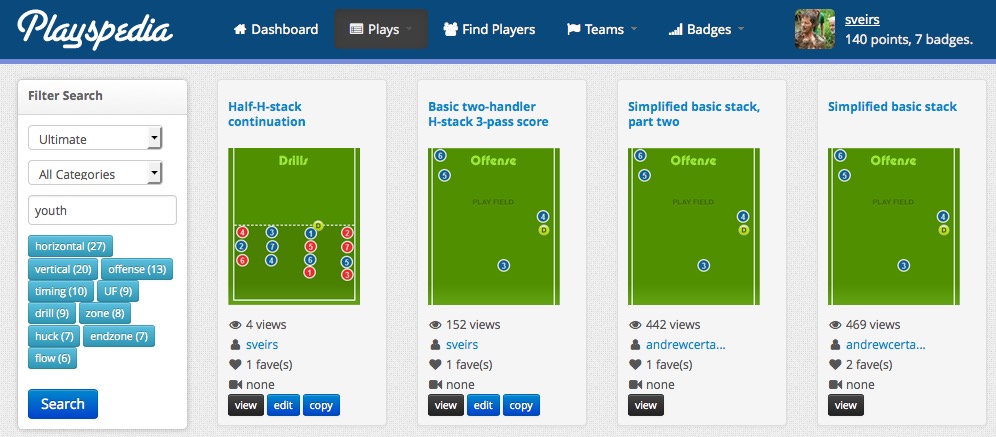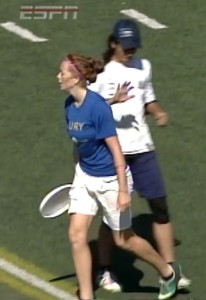Category Archives: Uncategorized
Schteattle Schtick: build ultimate skills in a fun game with 75 youth & 25 discs
Ok, here’s how Seattle kids play Schtick. We’re gonna call it Schteattle Schtick and it’s best played with 10-75 youth players (assisted by their coaches and/or parents) and lots of discs — at least 1 for every 3 players. (If you have more players and discs than this, you should play Galaxy Wars instead.) Either way, you’re in for a lot of fun and intense aerobic conditioning (even if there are minor inconsistencies with developing good fundamentals, e.g. you’re allowed to run with the disc)…

Here are the basic rules of Schteattle Schtick — forged on the first-mucky then sun-hardened grass fields of the DiscNW summer camp fields. The main difference from standard Schtick (described below) is that there is no stoppage of play upon scoring (in fact there really isn’t even any “keeping score” amid the mayhem), and there are no pulls — even at the start of the game. The Seattle variant simply adds these stipulations:
- The game cannot start until all players and all their discs (half the total available which must be at least 10) are packed inside the scorebox they will be defending. Everyone must be ready to rumble, and silent (ha, ha). The coach (or some responsible person) yells “go,” or whistles, and everyone runs amok.
- The only way to win is to get all discs out of your territory (across the middle line (hint: always keep at least one in reserve to counter stockpiling). You get a billion bonus points for getting all discs not only over the middle line, but also within the scorebox you are attacking (it’s never been done, BTW).
- Dimensions may vary based on team size and field space available.
- Follow the rest of the standard rules (see box & links below).
Local variants:
- If you have even more kids, you can add scoreboxes, e.g. two boxes per side!
- Played with a 2×2 box and a triangle half that size. Triangle worth 2 points. But we never really keep score of course!
- If you have way too many kids, try Galaxy Wars…
What is (Schtandard) Schtick?
From http://schtickdisc.org —
|
Using Playspedia.com to illustrate drills
Whether you’re trying to coordinate a practice plan with an assistant coach or “flipping the field” and giving your youth players some homework related to your offensive system, the Playspedia.com website can be a useful resource. The site allows you to register and create your own animations of drills, tactics, games, etc. You can then embed the animation (e.g. in your team web site), attach a YouTube video that further illustrates the animation, and then share the product via Twitter, Facebook, or a public or private link.
As an example, here’s the embedded version of a simplified horizontal stack continuation drill we use for 7th graders to help them begin to understand when and where to cut and throw to open space —
You can also search their database of plays, drills, and tactics. Sadly, a search for content tagged “youth” in the Ultimate sport only returns 4 results (as of fall 2015).

Let’s generate some more youth-specific content!
Video: the inclusive ultimate community in India
A beautiful short for a Sundance challenge that shows team Sky Wild and the interplay of the sport, education, and identity in Indian youth.
https://vimeo.com/114920914
Foul resolution in the women’s 2013 National Championships
I’ve been reading a lot recently about the on-going difference of opinions about self-officiation in ultimate at the National level. A central issue in the developing schism is the common complaint from spectators about the delays related to fouls and their resolution. I think miking the involved players, or at least a nearby observer, so that the crowd could listen in on the discussion would boost spectator interest, education, and value. I’d be excited to see this tried, at least with all observers in the games of the Triple Crown Tour organized by USA Ultimate, and with the referees officiating at the games played through Major League Ultimate or the American Ultimate Disc League.
A good example of this potential solution is the live-mikes used by some (one?) of the observers in the women’s 2013 National Championship game. I’ve provided the times of a couple fouls in which you can figure out what is going on because of that live audio feed. It’s fascinating stuff, giving insights both into the personalities of the players and the nuances of the rules and game! It would have been even more interesting if one could hear the players right from the start of the foul call, but even getting part of the discussion of the foul and associated rules was captivating.
1:18:40-1:19:30
Lauren Sadler went for it
Fouls called by colliding players nearby
Observer made call
1:19:50-
Silly travel called, then lifted
1:20:35-
Turf in the endzone
Foul called by thrower
Contested by marker
Observer resolves
As a coach or parent, would you be more willing to take your players to an MLU or AUDL game if instead of refs the semi-pro players were miked and self-officiating?!
